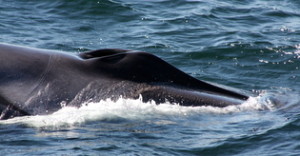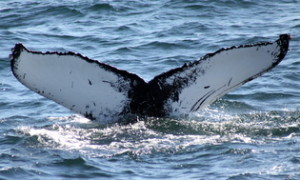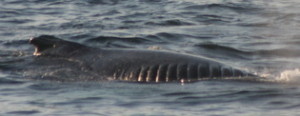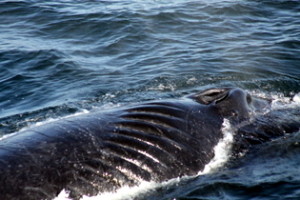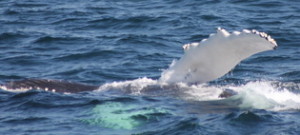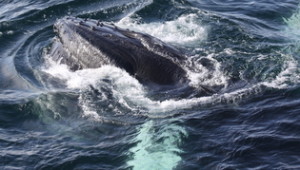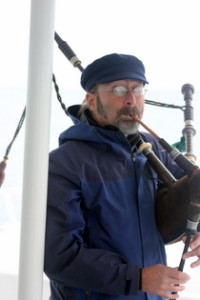October 8 to October 14
On October 8th we kicked off an unseasonably balmy Columbus Day weekend with some exciting trips offshore! On our morning trip, the highlight was a very close look at a sei whale. Sei whales have been showing up periodically over the past few weeks, most likely attracted to the krill patches that have been common throughout the region this fall. Sei whales are frequently spotted in small groups, but it is not unheard of to spot them by themselves, especially while they are foraging for food.
Later, we encountered a larger cousin of the sei whale — a fin whale. These animals are much more likely to be seen by themselves, and today was no exception. Fin whales and sei whales are frequently mistaken for one another due to their similar size and shape. This fin whale was easily distinguishable by the bright white patch on its lower right jaw, a characteristic shared with all members of the species.
Throughout the day we were able to locate more and more of a third species — the humpback. Amongst the eight individuals we saw on the afternoon’s trip, one of them was Basin, a whale first seen in 2009.
Another humpback was one that we couldn’t identify, but we did take note of the dramatic scarring pattern on the dorsal flukes. This whale’s tail was covered in rake marks, the more common name for scars from the teeth of sharks or orcas. These whales have no natural predators as adults, but as calves they are sometimes hunted by these large predators of the sea. Some have even hypothesized that one reason for the humpback’s long migration south is to give birth to their calves outside the habitats of the voracious orcas.
Aboard the Dolphin IX, after viewing feeding humpbacks and getting spectacular views of a pair of fin whales, 10-year old passenger Milo Cress reminded passengers about one major threat to the health of our oceans — marine debris, in particular, the plastic straw. Milo’s website, Be Straw Free urges restaurant-goers to reduce their impact on the environment by forgoing plastic straws. Plastics are a major threat to our oceans due to their ability to adsorb toxins, their lack of biodegradability, and their tendency to choke or collect in the stomachs of marine animal’s. Hat’s off to Milo for doing great work to promote an important cause!
The gorgeous weather continued into October 9th and we had another jaunt to the northeast. On the morning’s trip, we had 3-4 humpback whales lunge feeding, as well as 3 sei whales skim feeding. Marsh, who was Filament’s calf in 2007, was a member of the feeding group, and easily distinguished by the reedy marking on the underside of the fluke resembling marsh grass.
Even though they are feeding on the same prey, these two species make use of different feeding strategies, with the humpbacks energetically bursting through patches of food while the sei whales open their mouths and slowly graze down any prey collected at the surface.
In the afternoon, more humpbacks had joined the lunge feeding party, including one with a truly hideous prop scar. This smallest whale was obviously the victim of a ship-strike at some point during its life. Both large and small boats can injure, or even kill large whales, and in fact, ship strikes are a leading cause of death among humpbacks. We’re happy to see that this humpback survived, but its scar is a sad reminder of the risks these whales still face despite our efforts to protect them..
Finally, our last trip of the day was distinguished by a relatively unusual sighting — a group of pilot whales! While we normally see mostly baleen whales on our trip, pilot whales are one of the few species of toothed whales that we are able to see off the shores of Cape Cod, particularly in the fall. These whales can reach lengths of 16-20 feet, and they feed largely on squid. In this group of 10 – 15 animals, we noticed that there were even some mother and calf pairs.
Pilot whales are infamous in the region for mass strandings, and this weekend there were two sad cases of pilot whale strandings in Cape Cod Bay. One pilot whale came ashore and died on a Truro beach, while another very sick pilot whale came ashore in Plymouth and died later at the New England Aquarium. Click here for the full story.
On October 10th, warm air and bright sunshine ended a gorgeous holiday weekend, as numerous humpback whales dove and fluked high, their tails looking dark and shadowy against the glittering diamond glare of the sun. Our morning’s trip was characterized by very active humpback whales, one of whom spent most of the morning flippering and tail breaching to the east of Stellwagen Bank.
We also had some exciting views of birds, both from afar and at very close range. In additional to a rare seasonal glance at a Northern Fulmar on both the morning and afternoon’s trip, the surprise of the day was when a white-throated sparrow perched on the bow of the Dolphin VIII and then proceeded to land on a passengers’ head. Terrestrial birds like the sparrows sometimes find themselves offshore, especially during windy weather, and will sometimes land on the boat to rest before making their way back to land!
Beautiful weather continued into October 11th, though we found ourselves traveling fairly far to find whales — 18 miles to the northeast of Race Point, to be exact! But find them we did, We came across two extremely crowd-pleasing little humpbacks who were lunging their little hearts out at the surface. One of them was Liner’s 2010 calf. Now that we’ve seen that this whale has returned to Stellwagen Bank following its first year at its mother’s side, it will now get an official name, most likely based on markings on its flukes, next spring.
There was no sign of any bait at the surface, so we guessed that these humpbacks may have found a plankton patch that we couldn’t see from the boat. Humpbacks have long pectoral flippers that allow them a little bit more flexibility than other baleen whales in terms of their ability to corral prey. Due to the dexterity that these flippers lend them, they may feed on various types of small schooling fish, as krill and other plankton, depending on what is available.
After watching these two juvenile humpbacks for a while, we moved onto a single fin whale, who also lunged several times near the bow of the boat. After pursuing what looked like a tail breaching humpback in the distance, we found yet another lunge feeder! After a day filled with exciting surface behavior, we enjoyed fair winds on our return to shore.
October 12 was filled with another long search for whales. After spotting a large gray seal in the harbor, we traveled a total of 19.6 miles to the northeast of Race Point. The Dolphin IX came across Falcon, named for the bird silhouette on the left fluke. Falcon was first seen in 1998, and in all the years it has been seen off of Cape Cod, its sex has never been determined, either through a photo or genetic analysis!
Meanwhile, the Dolphin VIII found two fin whales and a small humpback who never showed us its flukes, making it very difficult to figure out its identity. This small whale tail breached several times, making our long journey offshore worth the trip!
Our trip out to the whales gave us ample time to watch for birds, and we still managed to see a lot. The jaegers between Long Point and Race Point continue to be great — it is possible to see both parasitic and pomerine species feeding not too far from shore. We are also seeing more and more Northern Gannets (over 120 just today!) Large flocks of Eider ducks continue to show up, and are mostly visible in the harbor. We also had two Sabine’s gulls between Long Point and Wood End, and we even had a look at a Common Murre further offshore. Keen eyes are spotting the occasional group of Scoters, and if we listen closely, we can often hear some Common Loons. Even though we expect to see them leave the area pretty soon, we are still regularly seeing Great Shearwaters and Manx Shearwaters. These pelagic birds will soon begin their migrations across hemispheres to breed before returning here next summer. On our long trip back to shore, we were delighted to have some entertainment from one of our passengers who brought his bagpipe aboard!






